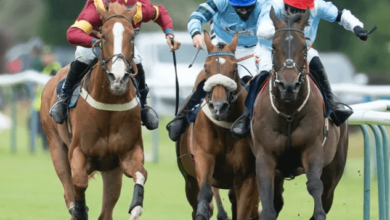How Can Pole Bending Skills Be Improved?

Pole bending is a dynamic and exhilarating equestrian event that challenges both rider and horse to weave through a series of six poles arranged in a line. This sport requires agility, speed, and precise communication between the rider and their horse. Improving your skills in pole bending can lead to better performance in competitions and a more enjoyable experience. This article will explore a range of techniques, training exercises, and expert tips to help you elevate your pole bending abilities.
Understanding Pole Bending
Pole bending is a timed event where horse and rider race down a path, weaving through a series of poles without knocking them over. It tests the agility and speed of the horse, as well as the rider’s ability to control and guide their mount effectively.
What is Pole Bending?
Originating from American rodeo practices, pole bending has evolved into a popular rodeo event and a competitive sport in other equestrian disciplines. It emphasizes the athletic ability of the horse and the skill of the rider, making it a spectator favorite.
History and Significance of Pole Bending
Understanding the roots of pole bending helps riders appreciate the sport’s values and traditions, fostering a deeper connection and respect for the competitive practice.
Fundamental Techniques in Pole Bending
To excel in pole bending, a rider must master several fundamental techniques, which serve as the building blocks for more advanced skills.
Basic Riding Skills Needed for Pole Bending
Before attempting to master pole bending, riders should have a solid foundation in basic equestrian skills such as mounting, galloping, and steering. These skills are crucial for navigating the poles successfully.
The Role of Horse and Rider Communication
Effective communication is key in pole bending. Riders must be adept at using cues from their body, legs, and reins to direct their horse through the course.
Techniques for Approaching and Weaving Through Poles
Developing a smooth and efficient approach to each pole is essential. This involves learning how to enter the pole pattern at the right angle and speed, and mastering the art of weaving without disrupting the horse’s rhythm.
Advanced Strategies to Enhance Performance
For those looking to take their skills to the next level, advanced strategies can provide the necessary edge in competitive pole bending.
Speed Optimization Techniques
To improve your time, focus on techniques that enhance your horse’s speed while maintaining control and accuracy. This includes training for explosive starts and quick, tight turns around the poles.
Agility Drills for Horses
Incorporate agility drills into your training routine to improve your horse’s flexibility and responsiveness. These can include zig-zag patterns, circle drills, and other exercises that encourage quick, precise movements.
Mental and Physical Conditioning for Riders
Riders need to be in top physical and mental shape to excel at pole bending. This section covers exercises and practices to keep riders fit and focused, such as cardiovascular workouts, strength training, and mental visualization techniques.
Training Exercises for Pole Bending
To effectively improve in pole bending, specific training exercises can be employed that mimic competition conditions and challenge both horse and rider.
Setting Up a Practice Course
Learn how to set up a practice pole bending course that mimics competition conditions. This includes the correct spacing and alignment of poles, as well as tips for using different types of equipment.
Daily Training Routines for Consistency
Develop a daily training plan that balances intensity with recovery. Consistent practice is key to mastering the timing and technique required for pole bending.
Incorporating Variability in Training
To prevent your training from becoming monotonous for both horse and rider, incorporate variations in the routine. This could involve changing the number of poles, adjusting the spacing, or practicing on different terrain.
Equipment and Gear
Choosing the right equipment is essential for effective training and successful competition in pole bending.
Choosing the Right Tack for Pole Bending
Selecting the appropriate tack is critical for safety and performance in pole bending. This includes choosing saddles, bridles, and other gear that offers both comfort and control.
Protective Equipment for Horse and Rider
Discuss the importance of using protective gear such as boots and leg wraps for the horse, and helmets and safety vests for the rider.
Competing in Pole Bending
Preparing for a Pole Bending Competition
Tips for preparing both mentally and physically for a competition, including what to do in the days leading up to an event and on the day itself.
Strategies for Competition Day
Advice on how to handle nerves, strategize your run, and make adjustments based on the competition environment.
Analyzing Performance and Handling Setbacks
Learn how to analyze your performance after a competition and handle setbacks constructively to improve in future events.
FAQs on Improving Pole Bending Skills
How often should I practice pole bending to see improvement? Consistent practice is key. Aim for at least three to four sessions per week, focusing on different aspects of the sport such as speed, agility, and accuracy.
What are some common mistakes in pole bending and how can I avoid them? Common mistakes include rushing the horse into the poles too quickly, leading to knocked poles, and poor timing of turns. Practice controlled approaches and clear communication with your horse to avoid these errors.
Are there specific breeds of horses that are better suited for pole bending? While many breeds can excel in pole bending, American Quarter Horses are often favored for their quick acceleration and agility.
How can I improve my horse’s response to directional cues? Regular training focusing on responsiveness to leg and rein cues is essential. Utilize exercises that reinforce these cues and always ensure consistency in your commands.
What mental strategies can help riders perform better under competition stress? Mental visualization, deep breathing exercises, and focusing on one pole at a time can help manage stress and improve performance during competitions.
How do I balance speed and accuracy to excel in pole bending? Focus on building a strong foundation of accuracy before gradually increasing speed. Training should emphasize precise movements, gradually increasing the pace as you and your horse become more confident.
Conclusion
Improving your pole bending skills is a multifaceted approach that involves dedicated practice, strategic training, and a deep understanding of both your horse and the sport. By focusing on these areas and consistently applying the tips and exercises outlined, you can enhance your performance and enjoy the thrill of mastering this exciting equestrian sport.







